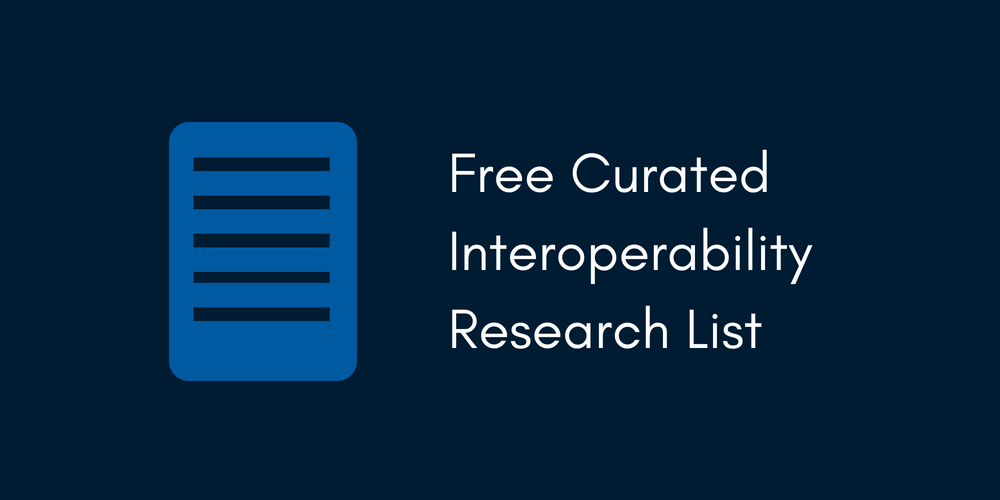Will We Ever Achieve Healthcare Interoperability? [Free Download]
Every day, thousands of patients depend on U.S. healthcare professionals to provide them with the best quality care. However, the quality of healthcare in America is not always reliable. In fact, medical errors are the third leading cause of death in the U.S. The lack of healthcare interoperability is a key contributor to this statistic.
Interoperability, or the extent to which different systems and devices can exchange, consume and interpret shared data, is pervasive in other industries but remains mostly absent in healthcare. For example, ATMs accept and distribute money belonging to different banks due to interoperability. Similarly, mobile phones can communicate across disparate cellular networks.
Interoperability is difficult for healthcare to achieve because healthcare is a complex industry with many moving parts. “Health information is inherently more complex than numbers in your bank account,” says Genevieve Morris, Principal Deputy National Coordinator for Health IT at the ONC. Multiple data formats, inconsistent data quality, data sensitivity, data ownership and data storage are all factors that contribute to the industry’s complexity and to the slow pace at which healthcare is approaching interoperability. In addition, health information is sensitive and heavily regulated, making the action of sharing it even more difficult. “From a security perspective, we’re dealing with much more serious issues than other industries, such as banking,” says Morris.
Recently, there have been several developments in the healthcare industry that have brought it closer to interoperability such as new interoperability standards (FHIR), the adoption of EHRs and new initiatives such as Apple Health Records and the MyHealtheData Initiative. In fact, the U.S. government has spent over $35 billion on EHRs since the initiation of the meaningful use program. But, despite technical innovation and this large chunk of investment, healthcare data exchange between providers remains rare.
Technical innovation alone will not result in an interoperable industry. For healthcare to be interoperable, the industry must achieve both technical and social interoperability. Social Interoperability, as defined by Dr. David Hay, member of the international standards community “refers to the willingness of participants to share data they have collected — and to the formation of a cross sector community to facilitate that.” With patient data sitting on disparate systems in multiple locations, it’s critical that not only the systems are able to share data, but also that the people in charge of those systems are willing to share data.
In an interview, Evelyn Gallego, Chair of HIMSS Interoperability and Health Information Exchange Committee, explains that technology is not what’s keeping us from achieving interoperability in healthcare, but rather policies, processes and workflows are the main obstacles. There are already technical solutions to the healthcare data exchange problem, now healthcare entities just need to adopt them.
Adopting new solutions, however, is easier said than done. The healthcare industry is largely organized around who owns healthcare data and who can control its alteration and distribution. Any change to that system would impact the “business” of healthcare, and disrupting the model of a $3 trillion industry is no simple task.
Despite resistance, an expectation has been set that the future of healthcare will be interoperable. Just last month CMS Administrator Seema Verma announced that beginning in 2019, hospitals will be required to provide access to a patient’s electronic health records the day they leave the hospital. To adhere to this new policy, hospitals and other healthcare entities will need to adopt solutions for timely, secure healthcare data exchange. We know this is possible, because the technology exists, but the industry still needs a mediator to help get it there. Payers and providers need someone who understands the vision for the future and has a practical road map for getting there.
We have been talking about interoperability for over a decade. There is a lot of research to sift through, so we put together a curated list of some of the best resources available. For your free list of curated interoperability research, click here.

![Will We Ever Achieve Healthcare Interoperability? [Free Download] Will We Ever Achieve Healthcare Interoperability? [Free Download]](https://www.pntdata.com/wp-content/uploads/bfi_thumb/dummy-transparent-pry0u8keamf832i1fwz4jg26xkwhzke7oak9pbq01k.png)


Very interesting article. Let’s see what the future brings into this evolving industry.